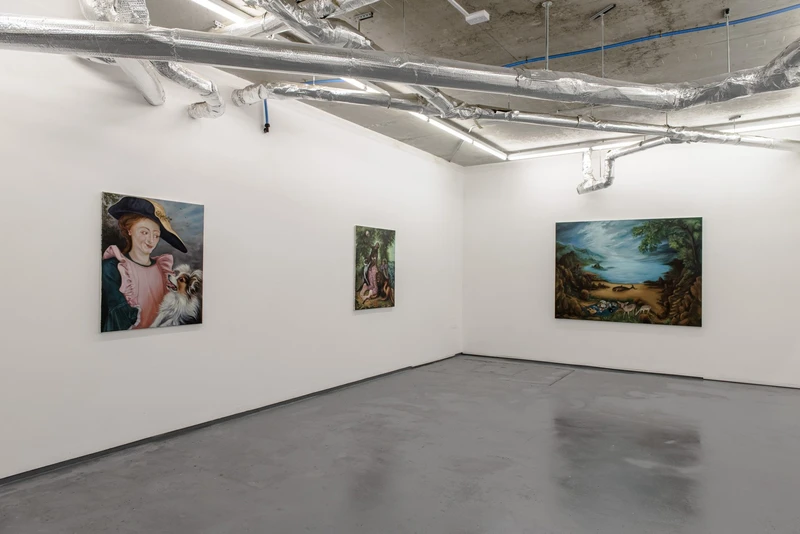Alex Hudson: Any Time Now
4 Mar-26 Jun 2021


Hudson makes reference to Shakespeare’s A Midsummer Nights Dream in the Painting ‘Supper at the Castle’ 2021. Here a couple at dinner are presented with a plate containing a moving and swirling fairy world that has been conjured like a Victorian parlor spectacle, complete with white rabbit. The scenes he depicts draw on a rich tradition of fantasy and magic, making reference to Henry Fuseli, Edward Robert-Hughes and William Blake. The magic here is however reimagined in a modern and technological context. As a series these works wander through the European tradition, and these journeys also reference the artist-as-wanderer, a nomad shrugging off societies mainstream norms and cultures.
In the painting Plato’s Bus 2020 Hudson attempts to address this transient state. As the title suggests this work nods to The parable of Plato’s Cave. Here though, as we witness the world of online scrolling, instagram streams and social media the horizon becomes less a promise of a destination and more of a chance or space to imagine.
In 2007 Alex Hudson saw Jan Brueghel the Elders tiny 25 x 35cm painting, ‘Vision of St. John on Patmos’ on his visit to the Doria Pamphili Collection in Rome. This minute work has inspired his viewpoint of the landscape, and his standpoint echoes the elevated position from which Brueghel took his vantage point. This is especially evident in End of Summer 2021, a large painting of an immense landscape conveying a sense of foreboding. In Painting The Baron, the cunning cultural mash-ups continue. The protagonist achieves an absurd balancing act seemingly buoyed up by the nymphs in the lily pond clad in his red yellow and blue lycra. This work cuts together Waterhouses’ ‘Hylas and the Nymphs’ of 1896 with ‘Threatened Swan’ by Dutch Painter Jan Asselijn of 1650, with the rather stunned protagonist looking as if he has been pushed through a Vivienne Westwood boutique in a hurricane.
In ‘Old Habits Die Hard’ 2020 the nomad, or artist-as-poet and rebel becomes a more rural, romantic, dandy. His frilly sensibility associated with idylls, Greek mythical stories and flamboyant legendary personalities. The inclusion of the lurid pink ubiquitous leopard print, questions the adornment of an animal print to inhabit the animal spirit. This is no Diana and Acteon, or man transformed, it is rather a recognition of our ongoing humanity as we succumb to the temptation and the often less savory nature that prevails in ‘the real world’.